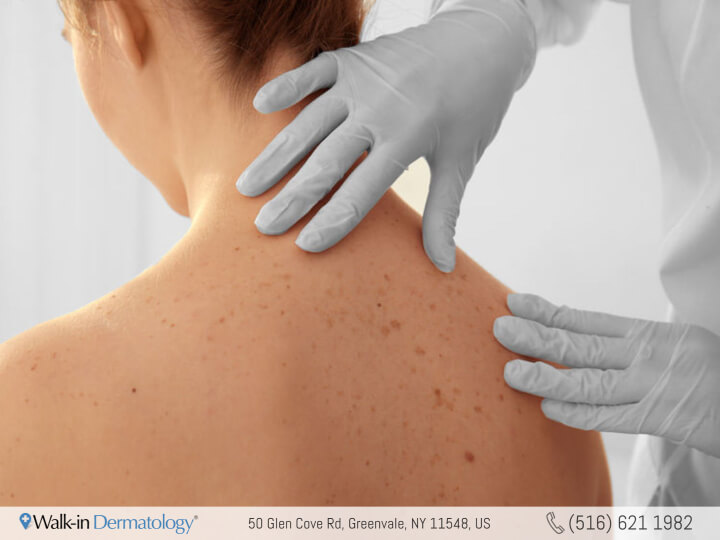Tues: 8:30am - 3:00pm
Wed: 12:00pm - 6:00pm
Thurs: 8:30am - 3:00pm
Fri: Closed
Sat: 8:30am - 12:30pm
Sun: Closed
Greenvale, NY 11548
The Difference Between Moles and Freckles


Freckles and moles are words often used interchangeably, but they aren’t the same. So, what’s the difference between them?
Moles are raised skin spots often appearing alone or in groups, whereas freckles are clusters of flat skin spots that are typically lighter in color. In this article, we break down the differences between moles and freckles to illustrate what makes a mole different from a freckle, as well as highlighting some tell-tale signs that your mole should be checked by a dermatologist.
What is a Mole?
Skin moles are a collection of melanocyte cells that often appear as black or brown spots. They typically appear alone but can also appear in groups. Most moles are “raised,” which is their distinguishing characteristic. With time, moles may shift in shape and dimension and can change color or raise above the skin.
Moles are considered temporary growths because they can appear and disappear. Disappearing moles often begin as a small flat spot, and become slightly raised overtime, then they can get pale and disappear.
Disappearing Moles: What do they Mean?
A change in the appearance of a mole is a common sign of possible cancer, but what does it mean if a mole disappears? Mole disappearances are not always linked to skin cancer. Other triggers may include:
- Natural changes: Moles are naturally evolving, which can often be mistaken as a sign of cancer. However, this isn’t always the case since it is common for moles to lighten over time as though they were on their way to disappearing. Consistent changes in a mole’s appearance are often no cause for alarm. When in doubt, it’s best to get in touch with a dermatologist.
- Different kinds of skin growths: Not all skin growths are moles. Skin tags, cysts, warts, and rashes – some of which eventually may heal on their own – can appear as moles to the untrained eye and trick people into thinking their mole has disappeared.
- Skin injury: Scars, burns, and other injuries inflicted on a site where a mole is may cause changes to the skin that can make the mole less visible. For instance, when part of the skin is torn or burned off, the mole may be less visible as a result.
If you notice that your mole is changing in shape, color, or texture, it’s always a good idea to get it looked at by a dermatologist. They can perform tests to understand the underlying reasons causing your mole to change in appearance.
Different Types of Moles
There are three common types of moles, including:
- Congenital Moles: These are the moles you are born with. Also referred to as plural nevi, these moles are often round or oval in shape and can be 1.5 cm in size or greater. About 1 in every 100 children are born with congenital moles. There is currently no known cause for congenital moles in babies.
- Acquired Mole: Also called a common mole, these are moles that appear on the skin after birth. Common moles are usually 5 mm to 6 mm in size and have a smooth surface, with pigmentation ranging from light to dark brown. Common moles typically appear with prolonged exposure to the sun, but rarely turn into skin cancer.
- Atypical Mole: Atypical moles or dysplastic nevus are moles that are larger in shape (more than 6 mm) and have both flat and raised components. Unlike most moles, the visual characteristics of an atypical mole aren’t consistent. Instead of having one shape, size, and color, atypical moles can appear splotchy and fuzzy, and in various colors or shades – all of which can be a cause for concern. Atypical moles are especially alarming when they’re itchy or irritating.
What is a Freckle?
Freckles are small clustered spots on the skin. More often than not, freckles appear after prolonged sun exposure, as the skin produces melanin triggered by exposure to UV rays. Unlike moles, freckles almost always appear in groups and rarely alone.
Freckles generally have the same appearance but can differ in color depending on the person’s genetics and complexion. For instance, freckles may appear reddish for some people and light brown for others. Regardless of the specific color, these are typically darker than the rest of the surrounding skin.
Two Types of Freckles
There are two categories of freckles:
- Ephelides: Freckles or “normal” freckles are spots that are either caused by sun exposure or genetic makeup. This type of freckle is more common in people who have light skin or blonde or red hair. On the other hand, people with darker hair, eyes, and skin are less likely to develop freckles. Ephelides freckles often appear on the face, upper body, and hands — all of which are areas that are prone to unprotected sun exposure. These freckles light up with sun protection or after the season changes.
- Lentigines: Lentigines, also called sun spots, are primarily caused by exposure to the sun and in particular, sunburn. These spots tend to be darker in appearance and don’t fade as easily as ephelides. They are also unlikely to fade or lighten with less sun exposure. Similar to ephelides freckles, sun spots appear in exposure-prone areas such as the face, chest, and arms.
Moles vs. Freckles: What’s the Difference?
Moles and freckles are two of the most common skin growths. One of the easiest ways to distinguish between the two is to simply feel the growth’s surface.
Moles are often raised whereas freckles are generally flat. Looking at the pigment can also give you an idea as to whether you’re looking at a mole or a freckle: the former is significantly darker, while the latter is typically only a few shades lighter than your skin color, and often appears reddish or light brown. Moles generally appear as one spot, whereas freckles appear in distinct groups.
The more significant difference between moles and freckles is that freckles rarely develop into skin cancer. The overproduction of melanin, which causes freckles to appear, often only changes the skin on a surface level.
On the other hand, more serious growths like moles can be symptomatic of cancer or another disease. Moles that are larger than a pencil eraser should be checked for cancer.
Can Freckles Turn Into Moles?
Freckles and moles are two different types of skin growths. Freckles occur as a result of sun exposure or genetics, whereas moles appear after skin cells develop into a cluster instead of spreading out into the skin. Ultimately, the mechanisms involved in the appearance of both are different and separate, meaning freckles can’t turn into moles and vice versa.
Signs You Need to Get Your Skin Checked
Freckles are rarely harmful and usually require no medical treatment. The appearance of freckles can be lightened with less sun exposure or proactive skin care involving broad-spectrum sunscreen with 50+ SPF.
Moles on the other hand, are known to develop into cancerous growths. Here are some signs that you should get your mole checked for skin cancer:
- Your mole is asymmetrical. If your mole is inconsistent in terms of shape, color, or size, there’s a possibility that this is a sign of skin cancer. Moles are generally no larger than ¼ inches in diameter (the size of a pencil eraser) – moles larger than this require attention.
- Your mole’s border is jagged or blurred. Common moles have distinct borders. If your mole’s edges are notched or irregular in any way, consider having it checked by a dermatologist.
- Your mole has some discoloration. Moles are typically brown or black. If your mole has patches of pink, red, white, blue, or a combination of these colors, you should be seen by a dermatologist.
Get Your Moles Checked at Walk-in Dermatology
Worried that your mole might be signaling something serious? At Walk-in Dermatology, we can help. Call us or book your appointment through our website to get the answers you’ve been looking for.








